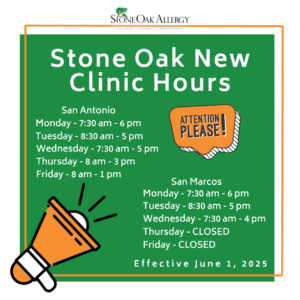January 13, 2021
How Allergies Present in Children vs. Adults

Most people discover they have allergies when they are young, but that is not always the case. About 1 in 5 people will develop allergies in their lives, and one in ten will develop asthma. Misconceptions about allergies and how they develop often lead people to dismiss them as merely an inconvenience. Far from being harmless, allergies have a significant impact on people’s lives.
The topic of allergies has become polarised into two camps: those who fear allergic reactions because they know a reaction can be lethal, and those who see allergies as trivial and, in some cases, even as if it is a dietary choice like veganism. The idea of ignoring someone’s allergy and doing something around them that would cause a severe reaction and harm has been treated as a punchline for famous comedians.
Since the root of this problem lies in a lack of education, those of us at Stone Oak Allergy want you to have the tools to inform those that fall into the second group.
The disconnect begins because many people don’t understand how an allergy presents itself. This is complicated because the ways allergies present can vary between adults and children.
Allergies in children tend to be more severe, especially food allergies. However, the signs aren’t always visible. Symptoms of a bad reaction can sneak up on parents, teachers, and caregivers and quickly progress to anaphylaxis, which is a condition with potentially life-threatening consequences.
To avoid severe reactions, children should be eased into an adult diet. It is recommended to introduce potential allergens to their diet slowly in small batches. By methodically introducing commonly allergenic ingredients, parents and caregivers can more easily identify the culprit and reduce the risk of severe damage.
Animal milk, gluten, eggs, nuts, fish, and seeds all fall into this bracket and should be introduced into the diet slowly. It is also worth considering that your child may develop an airborne allergy from certain kinds of animal dander and certain plants. Airborne allergies may cause the same symptoms as the food allergy symptoms listed below.
Allergies may present themselves with anything from mild respiratory issues or dermatological response or something as severe as anaphylaxis. As you introduce new foods, you should watch for these symptoms:
- Coughing, wheezing, or shortness of breath
- Irritation of the throat, tongue, or skin
- Rashes or hives
- Vomiting, diarrhea
- Swelling of the throat and/or mouth
- Eye irritation and redness
- Blocked or running nose
Several studies indicate that allergies are far from static. Younger children commonly present atopic eczema, gastrointestinal symptoms, wheezing, and food allergy. Meanwhile, older children present with asthma and allergic rhinoconjunctivitis, which is an inflammation of the inside of the nose. Children presenting allergies early in their life are also understood to be at greater risk of developing a further allergy later in life.
While in many cases, allergies in adults present with similar symptoms, such as itching around the throat and mouth in mild cases to anaphylaxis in severe reactions, they are usually easier to deal with because adults can usually discern and communicate about their discomfort more easily.
If you are looking for long term treatment for your allergies, Stone Oak Allergy is here to help. Treatment options to see your Stone Oak Allergy board certified Allergist about include:
- Allergy Shots – When allergy medicine and avoidance do not provide sufficient relief, allergy shots can make all the difference in a patient’s quality of life. They are not a quick fix, but many people find them to be well worth the time and effort. They can desensitize your immune system to pollen (trees, grass, weeds), insect stings, pet dander, dust, mold, and cockroaches. Removing these allergic reactions can result in relief from asthma, eczema, ear issues, and sinus troubles exacerbated by allergies.
- Cluster Immunotherapy – Many patients come to us frustrated by the duration and severity of their symptoms, and they embrace a faster route to relief! The abbreviated Cluster Immunotherapy build-up phase means patients start receiving the maintenance dose sooner. The maintenance dose is most effective at treating your specific allergies, so you should begin to feel better faster than with a slower schedule.
- Allergy Drops – Oral allergy drops have proven safe and effective for patients facing rhinitis, asthma, and eczema caused by airborne allergens including grass, pollen, ragweed, pet dander, mold, and dust mites.
If you’ve like to investigate more online, here is a list of helpful resources and further reading.
Allergies in Children from BSACI
Food Allergy Overview from the NHS
Food Allergy Overview from The American College of Allergy, Asthma and Immunology
